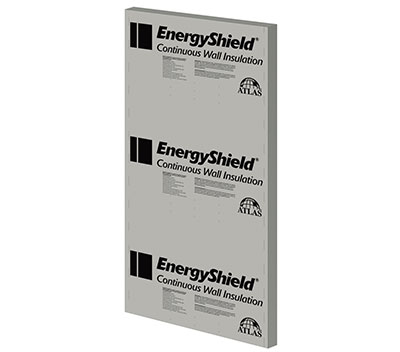

Description
Atlas EnergyShield Wall insulation is composed of a closed cell polyisocyanurate (polyiso) foam core, faced with tri-laminate foil. The blowing agent used to produce the polyiso foam core does not contain any CFCs, HCFCs or HFCs. EnergyShield has zero Ozone Depletion Potential (ODP) and negligible Global Warming Potential (GWP). EnergyShield combines high R-value, durable foil facers, and water resistive attributes in a high performance rigid wall insulation. EnergyShield is suitable for a variety of continuous insulation (CI) applications.
Panel sizes are 4ʹ by 8ʹ or 4ʹ by 9ʹ. Panels can be supplied in nominal 16ʺ or 24ʺ widths for use in masonry cavity wall applications. Custom sizes are also available.
| R-VALUE1,2 | NOMINAL BOARD THICKNESS |
|---|---|
| 3.3 | 0.5″ |
| 5.0 | 0.75″ |
| 6.5 | 1.0″ |
| 9.8 | 1.5″ |
| 10.5 | 1.6″ |
| 13.1 | 2.0″ |
| 19.7 | 3.0″ |
1Conditioned thermal values were determined by ASTM Test Method C 518 at 75° mean temperature. Test specimens were conditioned in accordance with procedures outlined in ASTM C1289, Section 11.1.2.1.
2“R” means resistance to heat flow. The higher the R-value, the greater the insulating power.
3Other sizes available upon request. Contact your local Atlas sales office.
EnergyShield is recommended for use in residential applications as well as some commercial construction applications. Check local building codes for compliance.
Common applications include:
- Exterior or interior rigid insulation (interior application requires a
thermal barrier) for walls framed with wood or steel studs - Exterior or interior continuous insulation (CI) for masonry or concrete wall systems, including exterior masonry cavities
- Exterior continuous insulation (CI) over wood or gypsum sheathings
- Use over existing cladding to improve energy efficiency with continuous insulation (CI) and provide a level surface prior to installing a new cladding
- Approved of use in attics and crawlspaces without requiring the use of a thermal barrier. (ICC-ES A12, Appendix B)
- Knee wall and vaulted ceiling applications (with an approved thermal barrier)
- Insulation for use in tilt-up wall panels
- Under slab insulation
- Various OEM applications
| PROPERTY | TEST METHOD | TEST METHOD MINIMUM REQUIREMENTS |
|---|---|---|
| FLAME SPREAD | ASTM E84 | <75 |
| SMOKE DEVELOPMENT | ASTM E84 | <450 |
| MOISTURE VAPOR TRANSMISSION (ASTM E96 DESICCANT METHOD) |
ASTM E96 | <0.1 Perm (5.7ng/(Pa•s•m2)) Class I vapor retarder per ICC |
| WATER ABSORPTION | ASTM C209 | <1% by Volume *Typical Results <0.5% by Volume |
| DIMENSIONAL STABILITY | ASTM D2126 | <2% Linear Change *Typical Results <1% Linear Change |
| SERVICE TEMPERATURES | – | -100°F to +250°F (-73°C to 122°C) |
- ASTM C1289 Type l, Class 1
- ASTM E84 Flame Spread, less than 75
- ASTM E84 Smoke Development, less than 450
- ASTM E2357 Air Barrier Assembly Test – Passed
- International Building Code (IBC), Section 2603
- International Residential Code (IRC), Section R316
- Water Resistive Barrier ICC-ES ESR-1375
- ASHRAE 90.1 / ASHRAE 189.1 / IECC / IGCC Continuous Insulation Standards
- Foil faced insulation greater than 1/2 inch thick is prescriptively defined as an air barrier material by IECC and ASHRAE 90.1
- Class l vapor retarder Sections on Foam Insulation
- California State Insulation Registry T 1231
- Miami-Dade County Approved
- California Approved Insulation Registry T 1231
EnergyShield can be used as part of a WRB and potentially part of an air barrier assembly. EnergyShield has passed ASTM E2357 as a component of an air barrier assembly. In these types of assemblies it is required that all joints, penetrations, and openings be taped or sealed by other means. Atlas recommends flashing EnergyShield into rough openings and other building transitions. The foil facers are compatible with most flashing or sheathing tape, joint fillers, sealants, and adhesives. Consult the product manufacturer for specific compatibility.


